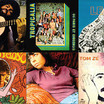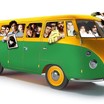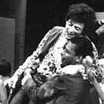Ruídos pulsativos

Geléia Geral
One of the principal expressions used to define Tropicalism is “carnivalization”. The movement is supposed to have caused a “carnivalization” of the serious Brazilian culture of the 60s. This link with Carnival can be understood by the history of the festival. Oswald de Andrade called Carnival the “religion of the Brazilian people“. Caetano Veloso saw in it “an example of an esthetic solution” and the “creative healthiness” of the Brazilian people.

“atrás do trio elétrico só não vai quem já morreu” Caetano Veloso
The origins of Carnival in the country go back to the merrymaking and festive games brought by the Portuguese when Brazil was still a colony. Over time, historic changes, regional diversification and, most importantly, elements assimilated from black African culture made the Carnival into the singular event it is today: a great party that mobilizes the whole country from north to south and which has, as its principal manifestations, the samba school parades and the “trios elétricos” (amplified musical trios atop mobile trucks).

The samba school parades that originated in Rio de Janeiro form an extraordinary choreographed spectacle. Visual artist Hélio Oiticica, one of Tropicalism’s iconic figures, paraded with the Mangueira samba school. Nevertheless, it is in the carnival of Salvador, Bahia, that one finds a truly popular street festival. Animated by the trios elétricos (amplified musical trios atop mobile trucks) it is the carnival ritual that most influenced that most influenced Tropicália. Having been internalized as a language, the carnival tradition extended to the formal aspect of the compositions, the artists’ stage performance and to the show itself. It became so deeply embedded in the Tropicalist esthetic that it also became embedded in Brazilian culture. As a form of “dues payment”, Caetano Veloso, with the song “Atrás do trio elétrico” (“Following the trio elétrico”), and Gilberto Gil, with the song “Filhos de Gandhi” (“Sons of Gandhi”), made decisive contributions to the resuscitation of Bahia’s street carnival.























